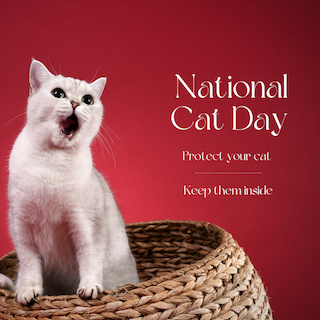by Rebecca Gilman
WSO Secretary and Conservation Committee Co-chair
Unless you’re a cat lover you may not know that October 29th is National Cat Day. Established in 2005, the day celebrates cats and promotes their adoption from shelters and Humane Societies. Birdwatchers are not usually counted among the ranks of cat lovers, so it may come as a surprise that the Wisconsin Society for Ornithology (WSO) is speaking out in support of National Cat Day. A world in which every cat has a happy, safe, forever home – meaning a home indoors – is a world we should all want to live in.
Founded in 1939, the WSO is a statewide organization whose mission is to promote the enjoyment, study, and conservation of birds. The conservation of cats does not fall under our mission statement. Yet we are very concerned about the welfare of cats. Why? Because the welfare of cats and the conservation of birds are inexorably intertwined.
Let’s start with cat welfare. There is no question that the safest, healthiest cats are cats who live their lives indoors. When cats are allowed to roam outside, they are exposed to a myriad of threats including death by cars, predators, poisons, traps, and extreme weather. Free-roaming cats are also susceptible to a range of diseases and parasitic infections – including zoonotic diseases such as toxoplasmosis and Bartonella henslae (which causes cat-scratch disease).
For these reasons, both the American Veterinary Medical Association and the Humane Society of the United States urge all pet owners to keep their cats indoors.
The WSO also urges all pet owners to keep their cats indoors – including its own members. After all, many of our members (and even some of our board members!) own cats – cats that we keep inside because we love them and want to protect them.
Which is not to say that pet owners who allow their cats to roam outside don’t love their cats. In fact, it is generally the opposite case. When I was growing up, my family had several outdoor cats. Not all at the same time, though. One beloved cat ran away and our next cat got run over by a car. Yet in spite of this clear and heartbreaking evidence to the contrary, we believed that keeping a cat indoors was cruel. We couldn’t imagine that an indoor cat was a happy cat. We were wrong.
There are countless ways to keep an indoor cat happy and entertained. There are indoor cat trees for vertical climbing, catnip toys in every shape and size, robotic mice … cats even have their own YouTube channel featuring enough videos of flitting birds and scampering squirrels to satisfy the natural hunting instincts of any feline.
Pet owners also have the option of creating a controlled indoor/outdoor environment for their cats. Enclosed structures like “catios” give cats all the benefits of an outdoor life without any of the dangers. Leash-training provides another safe way to take a cat outside.
“Safe” is the operative word here. Because for the WSO, keeping our cats safe means keeping the birds safe. And that is of paramount importance to us and to the planet. Many of us have made the study of birds our life’s work. All of us have found joy, friendship, inspiration, and solace in birdwatching. In short, we can’t imagine a world without birds.
Sadly, though, we’re being asked to. Because the birds are disappearing.
In 2019, researchers at seven institutions – including Georgetown University, Cornell University, and the Smithsonian – found that North America has lost thirty percent of its birds since 1970. That is 2.9 billion breeding adult birds, in every ecosystem, gone. That’s more than one in four birds gone. In one lifetime.
The researchers’ findings, published in Science, concluded that the leading causes for this staggering decline in bird populations were human-caused factors including habitat destruction, window collisions, and – yes – free-roaming cats. Why do cats pose such a dire threat to birds? Because they are an introduced species. Birds did not evolve alongside cats as they did with other predators. They have no natural defenses against them, so cats can decimate bird populations without even trying.
Estimates of the number of birds killed by cats each year ranges from the millions to the billions. For many, these numbers are hard to believe. People wonder, if so many birds are killed each year, then why aren’t all of our birds dead by now?
The answer is that there are still several billion birds left in North America and those birds reproduce each year. However, reproduction rates decline in tandem with the decline in the general bird population. With the general bird population in such steep decline, we are already observing many bird populations that are unable to absorb any additional, preventable losses.
That’s why even one bird killed by a cat, is one bird too many.
Thus, we urge all animal shelters, Humane Societies, and veterinarians across the state to educate their clients about the risks that both birds and cats face when their pets are allowed to roam outside. Additionally, we encourage shelters to ask anyone who wishes to adopt a cat to sign a pledge promising to keep their cats indoors. To be sure, many shelters and veterinarians take these steps already. To them we say, thank you. Keep up the good work.
To all cat owners we say, please join us in doing your part. For the love of our cats, and for the love of our birds, keep your cats indoors.


